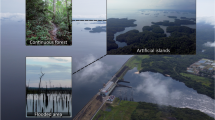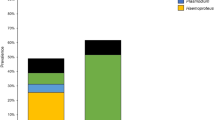Abstract
Exotic pathogens have been implicated in the decline and extinction of various native-island-bird species. Despite the fact that there is increasing concern about the introduction of diseases in island ecosystems, little is known about parasites in the islands of Macaronesia. We focus on Berthelot’s pipit (Anthus berthelotii), an endemic and widespread Macaronesian bird species, using a combination of field studies and molecular techniques to determine: (1) the range and prevalence of avian pox and malaria in Berthelot’s pipits throughout the species’ distribution, (2) the genetic characterization of both parasites in order to ascertain the level of host specificity. We sampled 447 pipits across the 12 islands inhabited by this species. Overall, 8% of all individuals showed evidence of pox lesions and 16% were infected with avian malaria, respectively. We observed marked differences in the prevalence of parasites among islands both within and between archipelagos. Avian pox prevalence varied between 0–54% within and between archipelagos and avian malaria prevalence varied between 0–64% within and between archipelagos. The diversity of pathogens detected was low: only two genetic lineages of avian malaria and one lineage of avian pox were found to infect the pipit throughout its range. Interestingly, both avian malaria parasites found were Plasmodium spp. that had not been previously reported in the Macaronesian avifauna (but that had been observed in the lesser kestrel Falco naumannii), while the avian pox was a host specific lineage that had previously been reported on two of the Canary Islands.




Similar content being viewed by others
References
Aljanabi SM, Martinez I (1997) Universal and rapid salt-extraction of high quality genomic DNA for PCR-based techniques. Nucleic Acids Res 25:4692–4693
Atkinson CT, Lease JK, Dusek RJ, Samuel MD (2005) Prevalence of pox-like lesions and malaria in forest bird communities on leeward Mauna Loa Volcano, Hawaii. Condor 107:537–546
Báez M, García A (2004) Diptera. In: Izquierdo I, Martín JL, Zurita N, Arechavaleta M (eds) Lista de especies silvestres de Canarias (hongos, plantas y animales terrestres) 2004. Consejería de Medio Ambiente y Ordenación Territorial, Gobierno de Canarias, pp 149–154
Beadell JS, Gering E, Austin J et al (2004) Prevalence and differential host-specificity of two avian blood parasite genera in the Australo-Papuan region. Mol Ecol 13:3829–3844
Beadell JS, Ishtiaq F, Covas R et al (2006) Global phylogeography limits of Hawaii’s avian malaria. Proc R Soc B 273:2935–2944
Bench S, Stjernman M, Hasselquist D et al (2000) Host specificity in avian blood parasites: a study of Plasmodium and Haemoproteus mitochondrial DNA amplified from birds. Proc R Soc B 267:1583–1589
Bonneaud C, Pérez-Tris J, Federico P, Chastel O, Sorci G (2006) Major histocompatibility alleles associated with local resistance to malaria in a passerine. Evolution 60:383–389
Buenestado F, Gortázar C, Millán J, Höfle U, Villafuerte R (2004) Descriptive study of an avian pox outbreak in wild red-legged partridges (Alectoris rufa) in Spain. Epidemiol Infect 132:369–374
Capela RA (1982) Contribuição para o conhecimento dos mosquitos (Diptera, Culicidae) dos arquipélagos da Madeira e das Selvagens. Bol Museu Mun Funchal 34:105–123
Carrete M, Serrano D, Illera JC, López G, Vögeli M, Delgado A, Tella JL (2008) Goats, birds and emergent diseases: apparent and hidden effects of an exotic species in an island environment. Ecol Appl 00:000-000, in press
Chenna R, Hideaki S, Koike T, Rodrigo L, Gibson TJ, Higgins DG, Thompson JD (2003) Multiple sequence alignment with the Clustal series of programs. Nucleic Acids Res 31:3497–3500
Cramp S (1988) The birds of the Western Paleartic, vol 5. Oxford University Press, London
Fallon SM, Birmingham E, Ricklefs RE (2005) Host specialization and geographic localization of avian malaria parasites: a regional analysis in the Lesser Antilles. Am Nat 165:466–480
Foronda P, Valladares B, Rivera-Medina JA, Figueruelo E, Abreu N, Casanova JC (2004) Parasites of Columba livia (Aves: Columbiformes) in Tenerife (Canary Islands) and their role in the conservation biology of the Laurel pigeons. Parasite 11:311–316
Freed LA, Cann RL, Goff ML, Kuntz WA, Bodner GR (2005) Increase in avian malaria at upper elevation in Hawai’i. Condor 107:753–764
García R, Gallego D, Hernández E (2001) Influence of the north Atlantic oscillation on the Canary Islands precipitation. J Climate 14:3889–3903
Griffiths R, Double MC, Orr K, Dawson RJG (1998) A DNA test to sex most birds. Mol Ecol 7:1071–1075
Hall TA (1999) BioEdit: a user-friendly biological sequence alignment editor and analysis program for Windows 95/98/NT. Nucl Acids Symp Ser 41:95–98
Hazevoet CJ (1995) The birds of the Cape Verde Islands. B.O.U. Check-list No. 13. British Ornithologist’s Union, UK
Hellgren O, Waldenström J, Bench S (2004) A new PCR assay for simultaneous studies of Leucocytozoon, Plasmodium, and Haemoproteus from avian blood. J. Parasitol 90:797–802
Illera JC (2007) Bisbita Caminero Anthus berthelotii. In: Lorenzo JA (ed) Atlas de las aves nidificantes en el archipiélago Canario (1997–2003). Dirección General de Conservación de la Naturaleza-Sociedad Española de Ornitología, Madrid, pp 344–347
Illera JC, Emerson BC, Richardson DS (2007) Population history of Berthelot’s pipit: colonisation, gene flow and morphological divergence in Macaronesia. Mol Ecol 16:4599–4612
Jarmin S, Manvell R, Gough RE, Laidlaw SM, Skinner MA (2006) Avipoxvirus phylogenetics: identification of a PCR length polymorphism that discriminates between the two major clades. J General Virol 87:2191–2201
Jovani R, Tella JL (2006) Parasite prevalence and sample size: misconceptions and solutions. TRENDS Parasitol 22:214–218
Kleindorfer S, Dudaniec RY (2006) Increasing prevalence of avian poxvirus in Darwin’s finches and its effect on male pairing success. J Avian Biol 37:69–76
Laiolo P, Tella JL, Carrete M, Serrano D, López G (2004) Distress calls may honestly signal bird quality to predators. Proc R Soc B 271:S513–S515
Laiolo P, Serrano D, Tella JL, Carrete M, López G, Navarro C (2007) Distress calls reflect poxvirus infection in lesser short-toed lark Calandrella rufescens. Behav Ecol 18:507–512
Lee LH, Lee KH (1997) Application of the polymerase chain reaction for the diagnosis of fowl poxvirus infection. J Virol Methods 63:113–119
Loiseau C, Zoorob R, Garnier S, Birard J, Federici P, Julliard R, Sorci G (2008) Antagonistic effects of a Mhc class I allele on malaria-infected house sparrows. Ecol Letters 11:258–265
Lorenzo JA (Ed) (2007) Atlas de las aves nidificantes en el archipiélago canario (1997–2003). Dirección General de Conservación de la Naturaleza-Sociedad Española de Ornitología. Madrid
Martín A, Lorenzo JA (2001) Aves del Archipiélago Canario. Lemus, La Laguna
Medina FM, Ramírez GA, Hernández A (2004) Avian pox in white-tailed laurel-pigeons from the Canary Islands. J Wildlife Diseases 40:351–355
Møller AP, Nielsen JT (2007) Malaria and risk of predation: a comparative study of birds. Ecology 88:871–881
Oliveira P, Menezes D (2004) Birds of the archipelago of Madeira. Serviço do Parque Natural da Madeira/Arquipélago Verde produtos promocionais, Lda, Funchal
Ortego J, Calabuig G, Cordero PJ, Aparicio JM (2007) Genetic characterization of avian malaria (Protozoa) in the endangered lesser kestrel, Falco naumanni. Parasitol Res 101:1153–1156
Pérez-Tris J, Hellgren O, Krizanauskiene A, Waldenström J, Secondi J, Bonneaud C, Fjeldsa J, Hasselquist D, Bench S (2007) Within-host speciation of malaria parasites. PLoSOne 2:e235
Smith KF, Sax DF, Lafferty KD (2006) Evidence for the role of infectious disease in species extinction and endangerment. Cons Biol 20:1349–1357
Smits J, Tella JL, Carrete M, Serrano D, López G (2005) An epizootic of avian pox in endemic short-toed larks (Calandrella rufescens) and Berthelot’s pipits (Anthus berthelotti) in the Canary Islands, Spain. Vet Path 42:59–65
Snow DW, Perrins CM (1998) The birds of the western palearctic. Concise Edition. Vol. 2. Passerines. Oxford University Press, Oxford
Stattersfield AJ, Crosby MJ, Long AJ, Wege DC (1998) Endemic bird areas of the world. BirdLife conservation, Series 7. BirdLife, Cambridge
Sunnucks P, Hales DF (1996) Numerous transposed sequences of mitochondrial cytochrome oxidase I–II in aphids of the genus Sitobion (Hemiptera: Aphididae). Mol Biol Evol 13:51–524
Szymanski MM, Lovette IJ (2005) High lineage diversity and host sharing of malarial parasites in a local avian assemblage. J Parasitol 91:768–774
Tamura K, Dudley J, Nei M, Kumar S (2007) MEGA4: molecular evolutionary genetics analysis (MEGA) software version 4.0. Mol Biol Evol 24:1596–1599
Thiel T, Whiteman NK, Tirapé A, Baquero MI, Cedeño V, Walsh T, Uzcátegui GJ, Parker PG (2005) Characterization of canarypox-like viruses infecting endemic birds in the Galápagos islands. J Wild Diseases 41:342–353
Thomas NJ, Hunter DB, Atkinson CT (2007) Infectious diseases of wild birds. Blackwell, Oxford
VanderWerf EA, Buró MD, Rohrer JL, Mosher SM (2006) Distribution and prevalence of mosquito-borne diseases in O’ Ahu ‘Elepaio. Condor 108:770–777
van Riper C III, van Riper SG, Goff ML, Laird M (1986) The epizootiology and ecological significance of malaria in Hawaiian land birds. Ecol Monographs 56:327–344
van Riper C III, van Riper SG, Hansen WR (2002) Epizootiology and effect of avian pox on Hawaiian forest birds. Auk 119:929–942
Vargas H (1987) Frequency and effect of pox-like lesions in Galápagos mockingbirds. J Field Ornithol 58:101–102
Voelker G (1999) Dispersal, vicariance, and clocks: historical biogeography and speciation in a cosmopolitan passerine genus (Anthus: Motacillidae). Evolution 53:1536–1552
Waldenström J, Bench S, Kiboi S, Hasselquist D, Ottosson U (2002) Cross-species infection of blood parasites between resident and migratory songbirds in Africa. Mol Ecol 11:1545–1554
Waldenström J, Bench S, Hasselquist D, Östman Ö (2004) A new nested polymerase chain reaction method very efficient in detecting Plasmodium and Haemoproteus infections from avian blood. J Parasitol 90:191–194
Warner RE (1968) The role of introduced diseases in the extinction of the endemic Hawaiian avifauna. Condor 70:101–120
Wikelski M, Foufopoulus J, Vargas H, Snell H (2004) Galápagos birds and diseases: invasive pathogens as threats for island species. Ecol Society 9 5. [online] URL: http://www.ecologyandsociety.org/vol9/iss1/art5
Acknowledgments
José Luis Tella provided additional blood samples from Lanzarote and Fuerteventura islands. We are also grateful to the many friends who assisted with the sampling and provided accommodation in the Canary Islands. This work was supported by a postdoctoral fellowship from the Spanish Ministry of Education and Science (Ref.: EX2005-0585), by a grant from John and Pamela Salter Charitable Trust to JCI, and by a UK NERC fellowship to DSR. The Regional Government of the Canary Islands and Regional Government of Madeira gave permission to trap and ring birds. The Spanish Ministry of Environment gave permission to work in the National Park of Las Cañadas del Teide. The Cabildo of Fuerteventura provided accommodation in the Fuerteventura Island. Thanks also to the staff of the Natural Park of Madeira for providing logistical support in the Madeiran and Selvagen archipelagos and to the Portuguese Navy for transport to Selvagen Grande and Deserta Grande.
Author information
Authors and Affiliations
Corresponding author
Appendix
Appendix
Rights and permissions
About this article
Cite this article
Illera, J.C., Emerson, B.C. & Richardson, D.S. Genetic characterization, distribution and prevalence of avian pox and avian malaria in the Berthelot’s pipit (Anthus berthelotii) in Macaronesia. Parasitol Res 103, 1435–1443 (2008). https://doi.org/10.1007/s00436-008-1153-7
Received:
Accepted:
Published:
Issue Date:
DOI: https://doi.org/10.1007/s00436-008-1153-7




